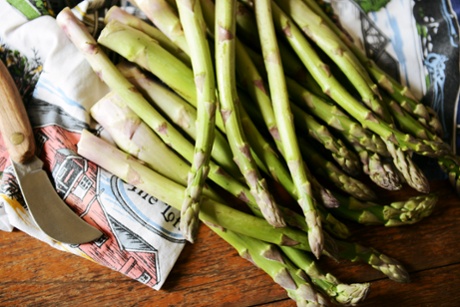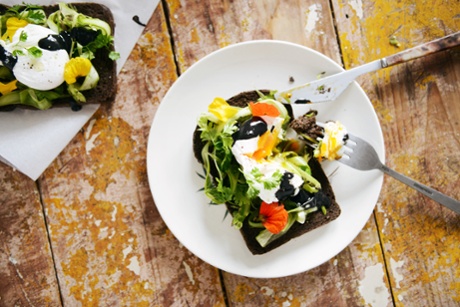Freshly picked asparagus - sweet and crunchy - perfectly combines with a poached egg on dark rye and black tahini.
Weeding a friend's giant veggie patch recently, we stopped our work to admire the asparagus plant. It was reaching its ferny limbs high, and at its base was a tall green asparagus, purple tinged. A scratch beneath the mulch revealed two more sprigs in various stages of growth. Growing in the dark, they were still white. Once exposed to the sun, the shoot pinks and then greens. The speciality white asparagus that you can buy is simply asparagus grown without light.
We snapped the green asparagus shoot at its base and ate it then and there, in the garden. It was sweet and crunchy, perfect without any adornment but, traditionally, the distinct herbaceous flavour of the asparagus is a great friend of butter, cream, soft goats cheese and lemon.
At the market look for stiff asparagus - you do not want it limp. Nor do you want an old, dry, woody asparagus so make sure it looks freshly picked. Take a look at their base, where they've been cut from the plant. They should snap loudly when broken - this is how you remove the woodier base of the asparagus before cooking. It naturally snaps at the best point. Discard this bottom section.

We've paired the asparagus classically with a poached egg, but served on a very dark rye which has an almost molasses flavour, and with a drizzle of black tahini over the egg, it looks striking. If you've not tried black tahini before, it's wonderful for both savoury and sweet dishes. Added to strawberries on a pancake, it is delightful. The taste is a little stronger than white tahini. The asparagus itself is raw, and peeled into dainty strips.
(Serves 2)
Open sandwich with asparagus and poached egg
2 slices of freshly baked dark rye bread
3 asparagus, peeled into ribbons
1 bunch of chervil
1 tsp lemon juice
1 tsp olive oil
1 pinch of sea salt flakes
3 tbsp white vinegar
2 organic free-range eggs
1 tbsp black tahini
Nasturtium flowers (for garnish)

Combine the olive oil, chervil, asparagus ribbons, lemon and salt in a bowl and carefully turn the ingredients until the asparagus is coated. Pile the asparagus mix onto the slices of rye to make a bed for the egg to rest on.
Bring a deep pot of water to the boil with the white vinegar. When boiling turn down to a moderate heat and carefully crack your eggs, one at a time, into the pot of water. The depth of the water matters, because the egg will cook as it falls through the water, and should be firm enough not to disperse when it hits the base of the saucepan. You don't want a shallow pan of water, the eggs will stick to the bottom.
Cook the eggs to your liking. The freshest eggs will poach the best. For firm whites and a runny yolk, the egg will hold but "give" a little when pushed.
Remove the eggs from the pot with a slotted spoon and rest on paper towel or a cloth to remove excess water, for just a moment. Place the eggs on your asparagus pile, drizzle with black tahini and then garnish with nasturtiums if available. Serve immediately.
Asparagus with poached egg looks striking served on dark rye. Photograph: Lauren Bamford







